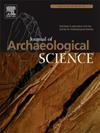大块骨古代宏基因组学揭示了南亚鱼类在公元8世纪穿越喜马拉雅山脉的运输
IF 2.6
1区 地球科学
Q1 ANTHROPOLOGY
引用次数: 0
摘要
鱼是(前)历史消费产品的重要组成部分。动物考古研究中基于保存较差的鱼骨进行形态鉴定,阻碍了(前)历史鱼类产品的研究。在这项研究中,我们对位于喜马拉雅中部南坡的孔桑桥遗址(公元652-768年)出土的无法识别的骨碎片进行了Bulk Bone Shotgun metagenomics (BBSM)分析。在其他物种中,发现了低地南亚鱼类Rohu (Labeo rohita),这是在青藏高原高海拔地区首次发现南亚鱼类。这一新的证据表明,鱼可能是由离开南亚的旅行者携带的,为他们的长途旅行提供必要的营养和能量,或者是从低地南亚平原沿着古吐蕃-尼泊尔路出口到青藏高原的。研究结果还表明,对无法识别的骨头碎片进行古代DNA分析,在提高我们对鱼类利用历史的理解方面具有巨大的潜力。本文章由计算机程序翻译,如有差异,请以英文原文为准。
Bulk-bone ancient metagenomics reveals the transport of South Asian fish across the Himalayas in the 8th century CE
Fish was an important component of (pre)historical consumption products. The study of (pre)historical fish products has been impeded by the morphological identifications in zooarchaeological research, based on poorly preserved fish bones. In this study, we applied the Bulk Bone Shotgun Metagenomic (BBSM) approach to unidentifiable bone fragments excavated from the Kongsangqiao site (dated to 652–768 CE) located on the southern slope of the central Himalayas. Among other species, the low-land South Asian fish species Rohu (Labeo rohita) was identified, marking the first discovery of a South Asian fish species on the high-altitude Tibetan Plateau. This new evidence suggests that fish may have been carried by travelers departing from South Asia to provide necessary nutritional sustenance and energy for their long-distance journeys, or was exported from the low-land South Asian plain to the Tibetan Plateau along the ancient Tubo-Nepal Road. The results also show the great potential of ancient DNA analysis on unidentifiable bone fragments in enhancing our understanding of the history of fish utilization.
求助全文
通过发布文献求助,成功后即可免费获取论文全文。
去求助
来源期刊

Journal of Archaeological Science
地学-地球科学综合
CiteScore
6.10
自引率
7.10%
发文量
112
审稿时长
49 days
期刊介绍:
The Journal of Archaeological Science is aimed at archaeologists and scientists with particular interests in advancing the development and application of scientific techniques and methodologies to all areas of archaeology. This established monthly journal publishes focus articles, original research papers and major review articles, of wide archaeological significance. The journal provides an international forum for archaeologists and scientists from widely different scientific backgrounds who share a common interest in developing and applying scientific methods to inform major debates through improving the quality and reliability of scientific information derived from archaeological research.
 求助内容:
求助内容: 应助结果提醒方式:
应助结果提醒方式:


